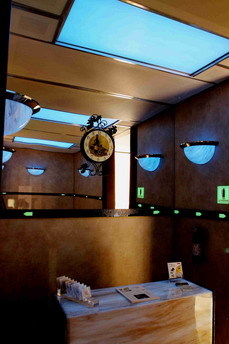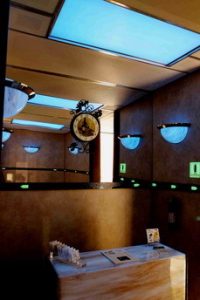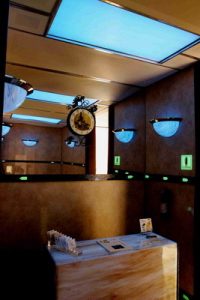Photoluminescent lighting can serve not merely as an aesthetic addition to any retail, restaurant or office space, but also as a safety enhancement.
This potential safety advantage , however, is often underestimated. For example, one story many might not be aware of is that following the World Trade Center bombing in 1995, the hand rails and stairs were painted with multiple layers of photoluminescent paint. Consequently, on 9/11, despite the terrible tragedy, thousands of people were able to exit the towers safely. Even though the power had been knocked out, the photoluminescent handrails and stairs worked as designed.
It doesn’t require a life-or-death crisis for photoluminescent lighting to prove its worth. During the power failure in 2003 that affected most of the northern seaboard as well as eastern Canada, thousands of people found themselves in darkness in places that did not necessarily have an emergency egress area – classrooms, conference rooms, bathrooms and hotel rooms (a particularly touchy situation, since the hotel guest is usually in unfamiliar surroundings). While lives were not lost as a result, many people skinned knees, bumped heads, and generally felt uneasy about what was happening.
There were back-up lighting systems, but according to the New York City building department, an estimated 30 percent of all the back-up systems under their jurisdiction failed to perform. Photoluminescent lighting could have ameliorated the predicament immensely.
The concept behind such photoluminescent lighting is to provide illumination without backup power sources during a power outage, or to extend the period of illumination once battery backup fails. Photoluminescent lighting comes in non-powered lighting panels or photoluminescent paint.
One company, Acrilex (Jersey City, N.J.), a manufacturer of custom colored acrylics, produces Acriglo, a photoluminescent series of acrylic sheets for lighting. The soft blue glow emitted from a fixture with Acriglo lasts several hours and provides light equivalent to moonlight – bright enough to help people see better in a blackout situation.
Since photoluminescent products are not required by law or covered by any specific building code, the challenge is in selling them to a facility’s management. This sparks the debate of code versus common sense: should building owners be content with building codes when it comes to the issue of safety or should they contemplate the implementation of additional common sense technology?
Another pressing question: why aren’t there building codes requiring items like these? The answer is that there is no category for photoluminescent lighting, and therefore no current building codes in which it can fit. It would require a unique code of its own governing its installation and usage.
A cursory glance at current building codes regarding light fixtures reveals that the codes govern the use of powered systems exclusively; in addition, the backups referred to in the codes are likewise powered systems. Thus, while a photoluminescent product would still be capable of performing the function required by the code – i.e., allowing building occupants to clearly view the “Exit” signs strategically located throughout the facility – those products are not taken into account. As a result, their usage remains totally voluntary for now.
One sector seeing the photoluminescent light is architects and designers. Often, these professionals are looking to provide additional features in a facility from both an aesthetic and safety perspective that can not only be installed without expansion of the building infrastructure but which can remain virtually invisible until they are needed. Photoluminescent lighting would fit the bill on both of these counts since it doesn’t require additional wiring and can basically remain in the background until its use is required.
Photoluminescent lighting can bring added safety to building owners and occupants, all at reasonable cost. Building owners, retailers and restaurants shouldn’t be left standing in the dark before they look into adding photoluminescents to their spaces.


 Photo Gallery1 week ago
Photo Gallery1 week ago
 Headlines3 days ago
Headlines3 days ago
 Headlines1 week ago
Headlines1 week ago
 Headlines1 week ago
Headlines1 week ago
 Designer Dozen2 weeks ago
Designer Dozen2 weeks ago
 Headlines1 week ago
Headlines1 week ago
 Designer Dozen6 days ago
Designer Dozen6 days ago
 Headlines1 week ago
Headlines1 week ago









